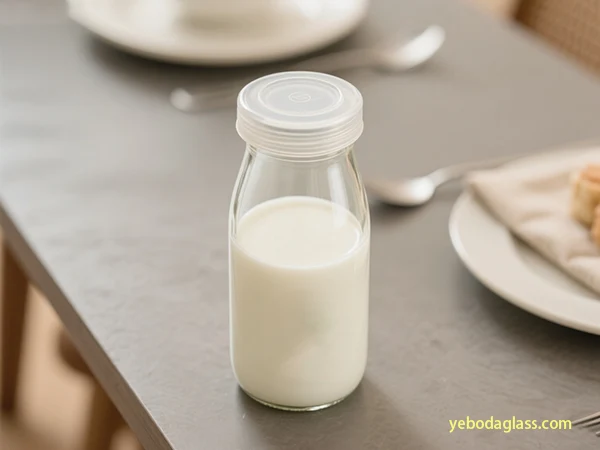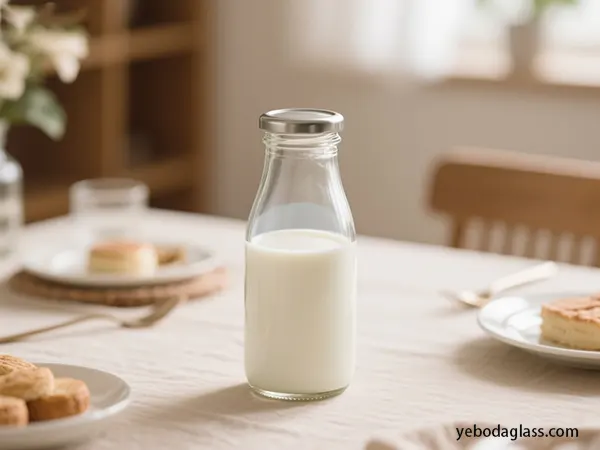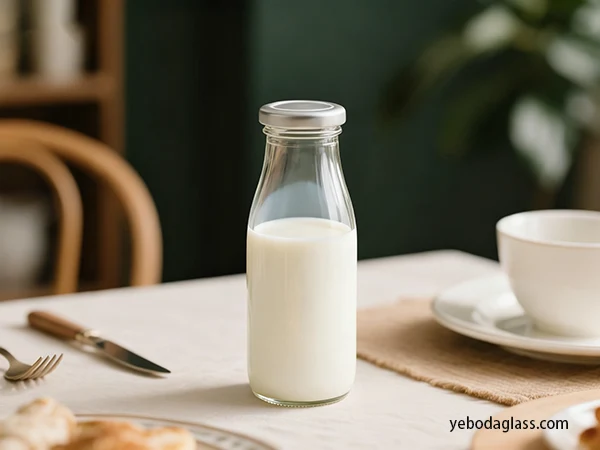Introdução
Recycled Content Integration (rPET, rHDPE): Conforming to international standards for the usage of recycled materials. Design for Recyclability: The use of single-material structures and the transparency of PET make the recycling process easier. Bioplastics:

Some potential biomaterials like PLA and bio-PE that could provide a completely renewable are gradually being introduced.
Chemical Recycling:
Making a plastic waste to be as new as a brand one, quality polymers, thus there is no limit to the number of reprocessing cycles.
- The milk bottle factory becomes more environmentally and financially sustainable with each step, thus the industry is getting closer to a fully circular model.
- Alternative and Novel Materials
R&D keeps searching beyond glass and plastic for:
Paper-Based Bottles:
- A completely renewable source but having some limitations in terms of durability. Compostable Polymers:
- Environmentally friendly materials, but their use is highly dependent on the availability of the industrial composting sector. Refill/Reuse Systems:
- Circular consumption models that are gaining popularity among premium brands. The milk bottle factory of tomorrow needs to be material-agnostic, yet environmentally friendly and technologically advanced to handle market and tech changes.
- Advanced Production Technologies and Automation Industry 4.0 is the era of digital transformation that is revolutionizing every milk bottle factory with precision, efficiency, and sustainability being the main features.
- Milk Bottle Factory Automation and Robotics Robotic Handling Systems:
Material flow can be optimized, labor requirements decreased, and product quality consistency can be confirmed through the use of these systems.
Automated Optical Inspection (AOI):
Implements AI to find the smallest defects in glass types.
AGVs and AMRs:
- Self-directed transport robots upgrade the internal logistics line by line safety getting better at the same time. An advanced milk bottle factory is fully automatic, so the entire production process from melting and forming to packaging and warehousing is done automatically.
- Energy Efficiency and Sustainable Operations New factories create maximum value out of all resources they use:
- Energy Recovery: The energy that is lost as hot air from furnaces is used again to heat materials that are preheated.
- Transparência: The usage of solar and wind energy help to reduce carbon emissions.
Water Recycling:
Closed-loop systems ensure that water consumption remains very low.
- Personalização: Data Analytics and Industry 4.0 Integration
- Leveza: They make possible to monitor temperature, pressure, and other quality parameters in real-time.
- AI & Predictive Maintenance: Is a tool that keeps the machine going, hence, the service life is extended.
- Digital Twins: Give the factory the capability to conduct simulations for productivity optimization.
Blockchain Traceability:

Helps to build customer confidence by providing Supply chain transparency.
After implementing digital transformation to the fullest extent, the milk bottle factory is a smart, interconnected production ecosystem.
- Functional, Aesthetic, and Smart Bottle Design Trends Bottle design is now strategic, integrating consumer psychology, ergonomics, and sustainability.
- Ergonomics and Consumer Experience Designers in every milk bottle factory focus on:
- Grip Comfort: Curved forms for better handling.
- Pour Control: Anti-drip spouts for cleanliness.
Ease of Opening:
Secure yet user-friendly caps for all demographics.
These small improvements significantly enhance user satisfaction.
- Aesthetics and Brand Differentiation Modern brands demand packaging that tells a story:
- Minimalist Elegance: Clean shapes and simple labels signal purity.
- Embossed Branding: Reinforces authenticity.
Green or transparent
communicate freshness and trust.
A skilled milk bottle factory collaborates with design teams to merge form and function, reinforcing the brand’s environmental narrative.
Smart Packaging Technologies
- Connectivity is the next wave of glass milk bottle design: QR Codes & NFC Tags:
- Help customers to see the origin of the product, obtain the sustainability information, and get engaged in the interactive experiences. Time-Temperature Indicators:
- Help customers to see the freshest milk visually. RFID Integration:
Improves supply chain transparency and makes counterfeiting more difficult.
These types of innovations convert normal bottles into smart communication devices that help not only to increase brand engagement but also to raise consumer trust levels.
Regulatory Landscape and Consumer Behavior
- The operations of milk bottle factories are influenced by government regulations and consumer sentiment, which can be regarded as two equally important factors. Regulatory Frameworks
- Plastic Waste Directives: A set of measures aimed at mandatory recycling and content quotas.
- The producers are responsible for the products’ end-of-life that they have put on the market. Food Contact Regulations:
Safety standards set for recycled plastics and glass milk bottles.
Labeling Standards:
- The main idea is the commitment of labeling to provide accurate sustainability-related information in order to prevent greenwashing. Each milk bottle factory has to adjust to these rules that are constantly changing in order to be in compliance and keep their brand integrity.
- Consumer Preferences Consumers of today want:
- Environmentally Friendly Packaging: Consumers opt for easily recyclable glass bottles and rPET containers.
- Rastreabilidade em Blockchain: QR-based traceability of milk origin.
Return and Reuse:
Circular systems are becoming more and more popular.
Those factories that are able to foresee these preferences will remain loyal to them in the future.
Strategic Implications for Industry Stakeholders
The changing packaging environment has implications in terms of risks and opportunities for the stakeholders of the industry.
- For Bottle Manufacturers Enable multi-material flexibility through investments in the milk bottle factory.
- Focus on AI and automation to improve your operational resilience. Create packaging that is both recyclable and reusable.
- Make use of environmental certifications to establish trust and gain credibility. For Dairy and Plant-Based Producers
Use diverse packaging portfolios as an advantage rather than a problem.

Collaborate with bottle suppliers on new product development to create value for both parties and customers.
On the positive side, sustainability efforts can be a great marketing tool.
- Figure out circular solutions and create partnerships that facilitate a closed-loop system. For Equipment Suppliers
- Prepare for the future by constructing adaptable, energy-saving machines that can work with the newest material types. Use the IoT and other control systems for machine integration and process optimization.
- Psicologia da Cor: Conclusion & Future Outlook garrafas de vidro The Path Ahead
Hyper-Personalization:
Tecnologias de embalagem inteligentes
Material Hybridization:
- The best of glass, paper, and bio-based plastics being merged to provide both superior and eco-friendly feature. Closed-Loop Systems:
- Smaller-scale recycling loops that are geographically closer to each other thus lessening waste production. AI-Driven Design:
- The use of AI to forecast how to get the best strength-to-weight ratio in material can lead to significant savings. Global Regulatory Alignment:
Easier conformity which in turn positions the business to undertake the sustainable scene more rapidly.
So, glass milk bottle manufacturing isn’t just a matter of production anymore; in fact, it is a pretty significant model for the way ecological packaging will look in the future whereby each milk bottle factory is delivering not only commodities but also making a valuable contribution towards a cleaner, smarter, and more circular global economy.
Comments
Submit A Review
- We’ve got you covered 24/7/365. Feel free to contact us, and get free samples. Hot Products
- Intermodal Transport: 100-300ml Round Glass Yogurt Milk Bottle – Small Dessert Jars Bulk
- Square Custom Glass Milk Bottles Bulk – 100-350ml Reusable Pudding and Beverage Container Oil Bottles Bulk Supply Guide: Save Costs, Boost Efficiency
- Full Name We focus on wholesale business, MOQ 1,000 pcs.
Each milk bottle factory has to adjust to these rules that are constantly changing in order to be in compliance and keep their brand integrity.
Preferências do consumidor
Consumers of today want:
- Environmentally Friendly Packaging: Consumers opt for easily recyclable glass bottles and rPET containers.
- Honesty: QR-based traceability of milk origin.
- Return and Reuse: Circular systems are becoming more and more popular.
Those factories that are able to foresee these preferences will remain loyal to them in the future.
Strategic Implications for Industry Stakeholders
The changing packaging environment has implications in terms of risks and opportunities for the stakeholders of the industry.
For Bottle Manufacturers
- Enable multi-material flexibility through investments in the milk bottle factory.
- Focus on AI and automation to improve your operational resilience.
- Create packaging that is both recyclable and reusable.
- Make use of environmental certifications to establish trust and gain credibility.
For Dairy and Plant-Based Producers
- Use diverse packaging portfolios as an advantage rather than a problem.
- Collaborate with bottle suppliers on new product development to create value for both parties and customers.
- On the positive side, sustainability efforts can be a great marketing tool.
- Figure out circular solutions and create partnerships that facilitate a closed-loop system.
For Equipment Suppliers
- Prepare for the future by constructing adaptable, energy-saving machines that can work with the newest material types.
- Use the IoT and other control systems for machine integration and process optimization.
- Offer complete automation and service packages to milk bottle factory clients whose business is continually changing.

Conclusion & Future Outlook
Traditionally the milk bottle factory has been a local production unit but now it is on its way to becoming a technological as well as an environmentally-friendly power center. The industry will be able to combine profit-making with ecological sustainability through embracing principles of circular economy, automating processes, and designing alongside that awareness.
The Path Ahead
- Hyper-Personalization: With 3D-printed molds, we might soon see formerly anonymous bottled become personalized editions for target groups.
- Material Hybridization: The best of glass, paper, and bio-based plastics being merged to provide both superior and eco-friendly feature.
- Closed-Loop Systems: Smaller-scale recycling loops that are geographically closer to each other thus lessening waste production.
- AI-Driven Design: The use of AI to forecast how to get the best strength-to-weight ratio in material can lead to significant savings.
- Global Regulatory Alignment: Easier conformity which in turn positions the business to undertake the sustainable scene more rapidly.
So, glass milk bottle manufacturing isn’t just a matter of production anymore; in fact, it is a pretty significant model for the way ecological packaging will look in the future whereby each milk bottle factory is delivering not only commodities but also making a valuable contribution towards a cleaner, smarter, and more circular global economy.




